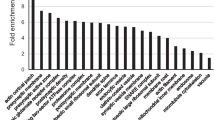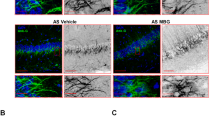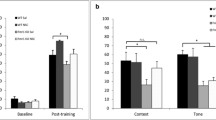Abstract
Emerging evidence is implicating abnormal activation of the mechanistic target of rapamycin (mTOR) pathway in several monogenetic neuropsychiatric disorders, including Angelman syndrome (AS), which is caused by deficiency in maternally inherited UBE3A. Using an AS mouse model, we show that semi-chronic rapamycin treatment improves long-term potentiation (LTP) and actin polymerization in hippocampal slices, spine morphology, and fear-conditioning learning. Activity of mTORC1 and of its downstream substrate, S6K1, was increased in hippocampus of AS mice. However, mTORC2 activity, as reflected by PKCα levels, was decreased. Both increased mTORC1 and decreased mTORC2 activities were reversed by semi-chronic rapamycin treatment. Acute treatment of hippocampal slices from AS mice with rapamycin or an S6K1 inhibitor, PF4708671, improved LTP, restored actin polymerization, and normalized mTORC1 and mTORC2 activity. These treatments also reduced Arc levels in AS mice. Treatment with Torin 1, an inhibitor of both mTORC1 and mTORC2, partially rescued LTP and actin polymerization in hippocampal slices from AS mice, while partially impairing them in wild-type (WT) mice. Torin 1 decreased mTORC1 and increased mTORC2 activity in slices from AS mice but inhibited both mTORC1 and mTORC2 in WT mice. Finally, an mTORC2 activator, A-443654, increased hippocampal LTP in AS mice and actin polymerization in both WT and AS mice. Collectively, these results indicate that events set in motion by increased mTORC1 and decreased mTORC2 activities, including increased Arc translation and impaired actin remodeling, are crucial in AS pathogenesis. Therefore, selectively targeting these two master kinase complexes may provide new therapeutic approaches for AS treatment.





Similar content being viewed by others
Abbreviations
- AMPAR:
-
α-Amino-3-hydroxy-5-methyl-4-isoxazolepropionic acid receptor
- Arc:
-
Activity-regulated cytoskeleton-associated protein
- AS:
-
Angelman syndrome
- BDNF:
-
Brain-derived neurotrophic factor
- CS:
-
Conditioned stimuli
- F-actin:
-
Filamentous actin
- i.p.:
-
Intraperitoneally
- LTP:
-
Long-term potentiation
- mTOR:
-
Mechanistic target of rapamycin
- PBS:
-
Phosphate-buffered saline
- PFA:
-
Paraformaldehyde
- TBS:
-
Theta-burst stimulation
- US:
-
Unconditioned stimuli
- WT:
-
Wild-type
References
Barry RJ, Leitner RP, Clarke AR, Einfeld SL (2005) Behavioral aspects of Angelman syndrome: a case control study. Am J Med Genet A 132A(1):8–12. doi:10.1002/ajmg.a.30154
Chamberlain SJ, Chen PF, Ng KY, Bourgois-Rocha F, Lemtiri-Chlieh F, Levine ES, Lalande M (2010) Induced pluripotent stem cell models of the genomic imprinting disorders Angelman and Prader–Willi syndromes. Proc Natl Acad Sci USA 107(41):17668–17673. doi:10.1073/pnas.1004487107
Dan B (2009) Angelman syndrome: current understanding and research prospects. Epilepsia 50(11):2331–2339. doi:10.1111/j.1528-1167.2009.02311.x
Peters SU, Beaudet AL, Madduri N, Bacino CA (2004) Autism in Angelman syndrome: implications for autism research. Clin Genet 66(6):530–536. doi:10.1111/j.1399-0004.2004.00362.x
Lalande M, Calciano MA (2007) Molecular epigenetics of Angelman syndrome. Cell Mol Life Sci 64(7–8):947–960. doi:10.1007/s00018-007-6460-0
Albrecht U, Sutcliffe JS, Cattanach BM, Beechey CV, Armstrong D, Eichele G, Beaudet AL (1997) Imprinted expression of the murine Angelman syndrome gene, Ube3a, in hippocampal and Purkinje neurons. Nat Genet 17(1):75–78. doi:10.1038/ng0997-75
Gustin RM, Bichell TJ, Bubser M, Daily J, Filonova I, Mrelashvili D, Deutch AY, Colbran RJ, Weeber EJ, Haas KF (2010) Tissue-specific variation of Ube3a protein expression in rodents and in a mouse model of Angelman syndrome. Neurobiol Dis 39(3):283–291. doi:10.1016/j.nbd.2010.04.012
Baudry M, Kramar E, Xu X, Zadran H, Moreno S, Lynch G, Gall C, Bi X (2012) Ampakines promote spine actin polymerization, long-term potentiation, and learning in a mouse model of Angelman syndrome. Neurobiol Dis 47(2):210–215. doi:10.1016/j.nbd.2012.04.002
Jiang YH, Armstrong D, Albrecht U, Atkins CM, Noebels JL, Eichele G, Sweatt JD, Beaudet AL (1998) Mutation of the Angelman ubiquitin ligase in mice causes increased cytoplasmic p53 and deficits of contextual learning and long-term potentiation. Neuron 21(4):799–811
van Woerden GM, Harris KD, Hojjati MR, Gustin RM, Qiu S, de Avila Freire R, Jiang YH, Elgersma Y, Weeber EJ (2007) Rescue of neurological deficits in a mouse model for Angelman syndrome by reduction of alphaCaMKII inhibitory phosphorylation. Nat Neurosci 10(3):280–282. doi:10.1038/nn1845
Kaphzan H, Hernandez P, Jung JI, Cowansage KK, Deinhardt K, Chao MV, Abel T, Klann E (2012) Reversal of impaired hippocampal long-term potentiation and contextual fear memory deficits in Angelman syndrome model mice by ErbB inhibitors. Biol Psychiatry 72(3):182–190. doi:10.1016/j.biopsych.2012.01.021
Heck DH, Zhao Y, Roy S, LeDoux MS, Reiter LT (2008) Analysis of cerebellar function in Ube3a-deficient mice reveals novel genotype-specific behaviors. Hum Mol Genet 17(14):2181–2189. doi:10.1093/hmg/ddn117
Huang HS, Burns AJ, Nonneman RJ, Baker LK, Riddick NV, Nikolova VD, Riday TT, Yashiro K, Philpot BD, Moy SS (2013) Behavioral deficits in an Angelman syndrome model: effects of genetic background and age. Behav Brain Res 243:79–90. doi:10.1016/j.bbr.2012.12.052
Greer PL, Hanayama R, Bloodgood BL, Mardinly AR, Lipton DM, Flavell SW, Kim TK, Griffith EC, Waldon Z, Maehr R, Ploegh HL, Chowdhury S, Worley PF, Steen J, Greenberg ME (2010) The Angelman syndrome protein Ube3A regulates synapse development by ubiquitinating arc. Cell 140(5):704–716. doi:10.1016/j.cell.2010.01.026
Kuhnle S, Mothes B, Matentzoglu K, Scheffner M (2013) Role of the ubiquitin ligase E6AP/UBE3A in controlling levels of the synaptic protein Arc. Proc Natl Acad Sci USA 110(22):8888–8893. doi:10.1073/pnas.1302792110
Chowdhury S, Shepherd JD, Okuno H, Lyford G, Petralia RS, Plath N, Kuhl D, Huganir RL, Worley PF (2006) Arc/Arg3.1 interacts with the endocytic machinery to regulate AMPA receptor trafficking. Neuron 52(3):445–459. doi:10.1016/j.neuron.2006.08.033
Rial Verde EM, Lee-Osbourne J, Worley PF, Malinow R, Cline HT (2006) Increased expression of the immediate-early gene arc/arg3.1 reduces AMPA receptor-mediated synaptic transmission. Neuron 52(3):461–474. doi:10.1016/j.neuron.2006.09.031
Shepherd JD, Rumbaugh G, Wu J, Chowdhury S, Plath N, Kuhl D, Huganir RL, Worley PF (2006) Arc/Arg3.1 mediates homeostatic synaptic scaling of AMPA receptors. Neuron 52(3):475–484. doi:10.1016/j.neuron.2006.08.034
Cao C, Rioult-Pedotti MS, Migani P, Yu CJ, Tiwari R, Parang K, Spaller MR, Goebel DJ, Marshall J (2013) Impairment of TrkB-PSD-95 signaling in Angelman syndrome. PLoS Biol 11(2):e1001478. doi:10.1371/journal.pbio.1001478
Ehninger D, Silva AJ (2011) Rapamycin for treating tuberous sclerosis and autism spectrum disorders. Trends Mol Med 17(2):78–87. doi:10.1016/j.molmed.2010.10.002
Costa-Mattioli M, Monteggia LM (2013) mTOR complexes in neurodevelopmental and neuropsychiatric disorders. Nat Neurosci 16(11):1537–1543. doi:10.1038/nn.3546
Costa-Mattioli M, Sossin WS, Klann E, Sonenberg N (2009) Translational control of long-lasting synaptic plasticity and memory. Neuron 61(1):10–26. doi:10.1016/j.neuron.2008.10.055
He Y, Li D, Cook SL, Yoon MS, Kapoor A, Rao CV, Kenis PJ, Chen J, Wang F (2013) Mammalian target of rapamycin and Rictor control neutrophil chemotaxis by regulating Rac/Cdc42 activity and the actin cytoskeleton. Mol Biol Cell 24(21):3369–3380. doi:10.1091/mbc.E13-07-0405
Huang W, Zhu PJ, Zhang S, Zhou H, Stoica L, Galiano M, Krnjevic K, Roman G, Costa-Mattioli M (2013) mTORC2 controls actin polymerization required for consolidation of long-term memory. Nat Neurosci 16(4):441–448. doi:10.1038/nn.3351
Jacinto E, Loewith R, Schmidt A, Lin S, Ruegg MA, Hall A, Hall MN (2004) Mammalian TOR complex 2 controls the actin cytoskeleton and is rapamycin insensitive. Nat Cell Biol 6(11):1122–1128. doi:10.1038/ncb1183
Thomanetz V, Angliker N, Cloetta D, Lustenberger RM, Schweighauser M, Oliveri F, Suzuki N, Ruegg MA (2013) Ablation of the mTORC2 component Rictor in brain or Purkinje cells affects size and neuron morphology. J Cell Biol 201(2):293–308. doi:10.1083/jcb.201205030
Sun J, Liu Y, Moreno S, Baudry M, Bi X (2015) Imbalanced mechanistic target of rapamycin C1 and C2 activity in the cerebellum of Angelman syndrome mice impairs motor function. J Neurosci 35(11):4706–4718. doi:10.1523/JNEUROSCI.4276-14.2015
Sun J, Zhu G, Liu Y, Standley S, Ji A, Tunuguntla R, Wang Y, Claus C, Luo Y, Baudry M, Bi X (2015) UBE3A regulates synaptic plasticity and learning and memory by controlling SK2 channel endocytosis. Cell Rep 12(3):449–461. doi:10.1016/j.celrep.2015.06.023
Briz V, Zhu G, Wang Y, Liu Y, Avetisyan M, Bi X, Baudry M (2015) Activity-dependent rapid local RhoA synthesis is required for hippocampal synaptic plasticity. J Neurosci 35(5):2269–2282. doi:10.1523/JNEUROSCI.2302-14.2015
Dindot SV, Antalffy BA, Bhattacharjee MB, Beaudet AL (2008) The Angelman syndrome ubiquitin ligase localizes to the synapse and nucleus, and maternal deficiency results in abnormal dendritic spine morphology. Hum Mol Genet 17(1):111–118. doi:10.1093/hmg/ddm288
Bornancin F, Parker PJ (1997) Phosphorylation of protein kinase C-alpha on serine 657 controls the accumulation of active enzyme and contributes to its phosphatase-resistant state. J Biol Chem 272(6):3544–3549
Sarbassov DD, Ali SM, Kim DH, Guertin DA, Latek RR, Erdjument-Bromage H, Tempst P, Sabatini DM (2004) Rictor, a novel binding partner of mTOR, defines a rapamycin-insensitive and raptor-independent pathway that regulates the cytoskeleton. Curr Biol 14(14):1296–1302. doi:10.1016/j.cub.2004.06.054
Oh WJ, Jacinto E (2011) mTOR complex 2 signaling and functions. Cell Cycle 10(14):2305–2316
Gu J, Lee CW, Fan Y, Komlos D, Tang X, Sun C, Yu K, Hartzell HC, Chen G, Bamburg JR, Zheng JQ (2010) ADF/cofilin-mediated actin dynamics regulate AMPA receptor trafficking during synaptic plasticity. Nat Neurosci 13(10):1208–1215. doi:10.1038/nn.2634
Liu Q, Chang JW, Wang J, Kang SA, Thoreen CC, Markhard A, Hur W, Zhang J, Sim T, Sabatini DM, Gray NS (2010) Discovery of 1-(4-(4-propionylpiperazin-1-yl)-3-(trifluoromethyl)phenyl)-9-(quinolin-3-yl)benz o[h][1, 6]naphthyridin-2(1H)-one as a highly potent, selective mammalian target of rapamycin (mTOR) inhibitor for the treatment of cancer. J Med Chem 53(19):7146–7155. doi:10.1021/jm101144f
Thoreen CC, Kang SA, Chang JW, Liu Q, Zhang J, Gao Y, Reichling LJ, Sim T, Sabatini DM, Gray NS (2009) An ATP-competitive mammalian target of rapamycin inhibitor reveals rapamycin-resistant functions of mTORC1. J Biol Chem 284(12):8023–8032. doi:10.1074/jbc.M900301200
Han EK, Leverson JD, McGonigal T, Shah OJ, Woods KW, Hunter T, Giranda VL, Luo Y (2007) Akt inhibitor A-443654 induces rapid Akt Ser-473 phosphorylation independent of mTORC1 inhibition. Oncogene 26(38):5655–5661. doi:10.1038/sj.onc.1210343
Bi X, Sun J, Ji AX, Baudry M (2015) Potential therapeutic approaches for Angelman syndrome. Expert Opin Ther Targets 1–13. doi:10.1517/14728222.2016.1115837
Lipton JO, Sahin M (2014) The neurology of mTOR. Neuron 84(2):275–291. doi:10.1016/j.neuron.2014.09.034
Sawicka K, Zukin RS (2012) Dysregulation of mTOR signaling in neuropsychiatric disorders: therapeutic implications. Neuropsychopharmacology 37(1):305–306. doi:10.1038/npp.2011.210
Bhattacharya A, Mamcarz M, Mullins C, Choudhury A, Boyle RG, Smith DG, Walker DW, Klann E (2015) Targeting translation control with p70 S6 kinase 1 inhibitors to reverse phenotypes in fragile X syndrome mice. Neuropsychopharmacology. doi:10.1038/npp.2015.369
Julien LA, Carriere A, Moreau J, Roux PP (2010) mTORC1-activated S6K1 phosphorylates Rictor on threonine 1135 and regulates mTORC2 signaling. Mol Cell Biol 30(4):908–921. doi:10.1128/MCB.00601-09
Hoeffer CA, Klann E (2010) mTOR signaling: at the crossroads of plasticity, memory and disease. Trends Neurosci 33(2):67–75. doi:10.1016/j.tins.2009.11.003
Steward O, Wallace CS, Lyford GL, Worley PF (1998) Synaptic activation causes the mRNA for the IEG Arc to localize selectively near activated postsynaptic sites on dendrites. Neuron 21(4):741–751
Andrade-Talavera Y, Benito I, Casanas JJ, Rodriguez-Moreno A, Montesinos ML (2015) Rapamycin restores BDNF-LTP and the persistence of long-term memory in a model of Down’s syndrome. Neurobiol Dis 82:516–525. doi:10.1016/j.nbd.2015.09.005
Johnson JL, Huang W, Roman G, Costa-Mattioli M (2015) TORC2: a novel target for treating age-associated memory impairment. Sci Rep 5:15193. doi:10.1038/srep15193
Angliker N, Ruegg MA (2013) In vivo evidence for mTORC2-mediated actin cytoskeleton rearrangement in neurons. Bioarchitecture 3(4):113–118. doi:10.4161/bioa.26497
Baudry M, Bi X (2013) Learning and memory: an emergent property of cell motility. Neurobiol Learn Mem 104:64–72. doi:10.1016/j.nlm.2013.04.012
Acknowledgments
This work was supported by Grants P01NS045260 (PI: Dr. C.M. Gall) and R01NS057128 from NINDS to MB and R15MH101703 from NIMH to XB. XB is also supported by funds from the Daljit and Elaine Sarkaria Chair.
Author information
Authors and Affiliations
Corresponding author
Ethics declarations
Conflict of interest
The authors declare no conflict of interest.
Additional information
J. Sun and Y. Liu contributed equally to this work.
Electronic supplementary material
Below is the link to the electronic supplementary material.
Rights and permissions
About this article
Cite this article
Sun, J., Liu, Y., Tran, J. et al. mTORC1–S6K1 inhibition or mTORC2 activation improves hippocampal synaptic plasticity and learning in Angelman syndrome mice. Cell. Mol. Life Sci. 73, 4303–4314 (2016). https://doi.org/10.1007/s00018-016-2269-z
Received:
Revised:
Accepted:
Published:
Issue Date:
DOI: https://doi.org/10.1007/s00018-016-2269-z




